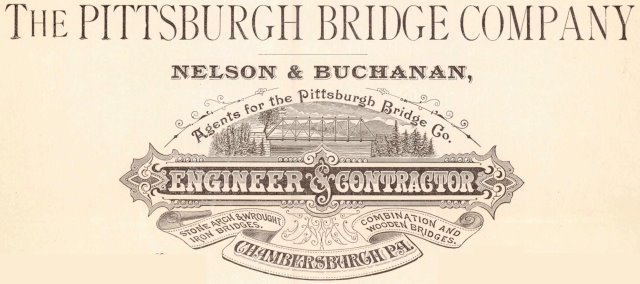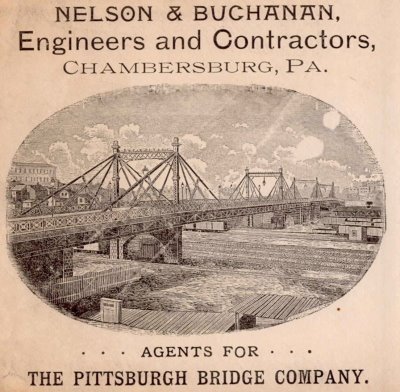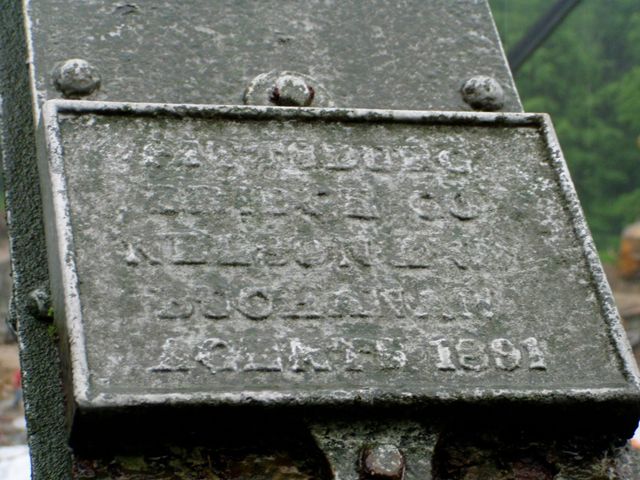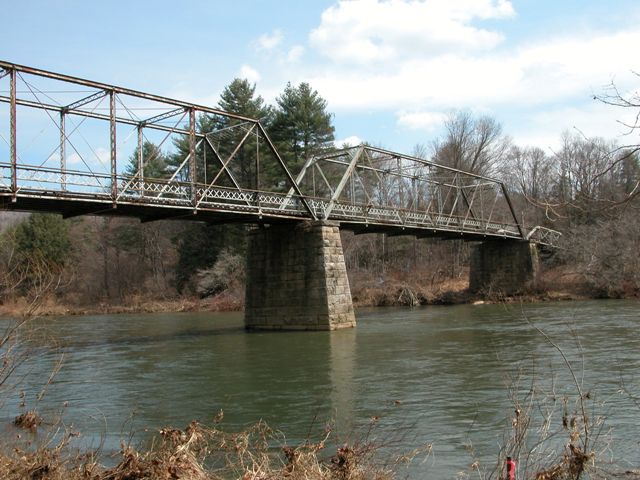We Recommend:
Bach Steel - Experts at historic truss bridge restoration.
BridgeHunter.com Phase 1 is released to the public! - Visit Now
Shanley Road Bridge
Maxwell Run Bridge
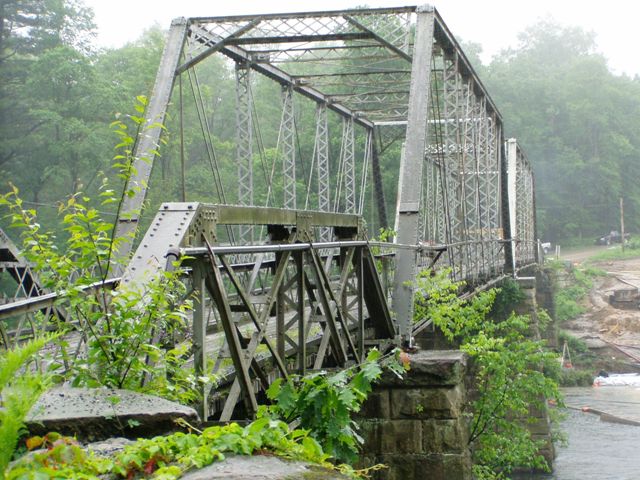
Primary Photographer(s): Nathan Holth
Bridge Documented: June 10, 2004
Rural (Near Hallton): Elk County, Pennsylvania: United States
Metal 7 Panel Pin-Connected Pratt Through Truss, Fixed and Approach Spans: Metal 4 Panel Rivet-Connected Double-Intersection Warren Pony Truss, Fixed
1891 By Builder/Contractor: Pittsburgh Bridge Company of Pittsburgh, Pennsylvania, Nelson and Buchanan of Chambersburg, Pennsylvania Agents
1905
118.0 Feet (36 Meters)
341.0 Feet (103.9 Meters)
12.5 Feet (3.81 Meters)
2 Main Span(s) and 2 Approach Span(s)
24721003080005

View Information About HSR Ratings
Bridge Documentation
This bridge no longer exists!
This bridge's song is:
View Archived National Bridge Inventory Report - Has Additional Details and Evaluation
View An Archived Discussion of This and Two Nearby Historic Bridges From Disappearing Bridges, a Website That No Longer Exists
This 113 Year Old Bridge Was Demolished Early November, 2004
Technical Overview and History of Bridge
The Shanley Road Bridge was known as the Maxwell Run Bridge locally, because of the nearby Maxwell Run that empties into Clarion River near the bridge. The bridge was a four span through and pony truss bridge. It featured two Pratt through main spans, with an approach pony truss span at each end. The approach spans could be called either Pratt truss spans with counters on all panels, or they could also be listed as double-intersection Warren pony truss spans. Because of their short length, they are hard to nail down to a particular configuration. The deck of the bridge was wood, and was 12.5 feet wide. There was 14.3 feet of vertical clearance on the bridge. The approach spans were 50 and 55 feet in length. The main spans were each 115 feet long. This yielded a total of 335 feet in length for the bridge. The bridge was posted at a three ton weight limit at the time of replacement. When PennDOT and Elk county sought replacement of the bridge, they publicly offered the truss bridge to anyone willing to pay the costs to move and rehabilitate the bridge at a different location. A number of inquiries were received, but no one actually decided to move the bridge. A replacement structure was built in 2004, 50 feet downstream from the location of the truss bridge. The truss bridge was demolished after the replacement structure was completed, during the first week of November.
The Shanley Road Bridge was built in 1891, and in 1905 the approach spans were replaced with the ones present when the bridge was demolished. The builder of the 1891 spans for the bridge was the Pittsburg [sic] Bridge Company, under the direction of its agents, Nelson and Buchannan, of Chambersburg, Pennsylvania. The 1905 approach spans were also a product of Nelson and Buchanan, but this time without the Pittsburgh Bridge Company relationship. This is one of the things that made the Shanley Road Bridge so unique... because it had spans from two different years but both associated with Nelson and Buchanan, it demonstrated in a very visual way the history of Nelson and Buchanan. For a number of years mostly in the 1890s, Nelson and Buchanan and Pittsburgh Bridge Company had a nearly inseparable working relationship with each other. Usually if one of the two names can be associated with an 1891 bridge, the other was likely involved too. The pin-connected main spans of the Shanley Road Bridge display the typical overall appearance and construction details that was exhibited by the bridges built under this relationship, from the portal bracing design to the odd method of framing the floorbeams. In the early 20th Century however, Nelson and Buchanan went its own way as an independent company. A number of pony trusses built by Nelson and Buchanan remain in southwestern Pennsylvania. Their pony truss bridges with riveted connections had a distinctive appearance, including the double-intersection Warren truss design, wide, lightweight outriggers, and their bridges often had hub guard railing that was v-laced instead of the usual lattice. The approach spans on the Shanley Road Bridge did not have the v-laced railings, instead continuing the existing lattice railing, but the other typical details and appearances were there. The steel for the 1905 approach spans were fabricated by Carnegie steel. Courtesy Cumberland County, Pennsylvania, the image to the right shows a plan sheet for a Nelson and Buchannan pony truss similar to the approach spans on Shanley Road Bridge and other pony truss spans the company designed and built under its own name.
It is not known what the approach spans that preceded the 1905 spans looked like, nor why they did not last very long. However the plan sheet for a proposed pin-connected pony truss that Nelson and Buchanan produced for a bridge (not the Shanley Road Bridge) suggests what the original spans might have looked like. In particular, the very short truss span shown at the bottom of the plan sheet may offer a good guess as to what the spans looked like.
Thanks to the digitized archives of Cumberland County, Pennsylvania, pages from original proposals and specifications for truss bridges are available to provide a look into the Pittsburgh Bridge Company / Nelson and Buchanan and the typical conduct and business operation of it and other bridge companies of the late 19th Century. The images of logos, drawings, and documents seen in this narrative are taken from the proposals. Although the proposals are for bridges in Cumberland County, Pennsylvania it is likely representative of the sort of proposal that would have have been supplied by the company for the Shanley Road Bridge and other bridges the company built. During this period in history, the purchaser (city, county, etc) often did not produce a very detailed contract proposal as is done today, and instead the contractor (the bridge company) often took the lead role in not just construction, but engineering as well. This is why the Shanley Road Bridge has design details that associate it with Pittsburgh Bridge Company / Nelson and Buchanan, rather than with the design of a county or township. If a different company, such as the Wrought Iron Bridge Company had been hired instead, the bridge would undoubtedly have had completely different design details; the details that Wrought Iron Bridge Company used. Also, the proposal, specifications, and plan sheets provided for these bridges to the purchaser were often nowhere near as detailed as plans and specifications seen for bridges in the 20th Century, where owner agencies began to took the lead role in design. View a collection of some of the proposal sheets and some drawings for bridges in PDF format. Again, these are not for the Shanley Road Bridge, but for other bridges the same company built. The documents were digitized by Cumberland County, Pennsylvania.
Information and Findings From Pennsylvania's Historic Bridge InventoryDiscussion of Bridge The 344'-long bridge consists of a pin connected, 2 span, Pratt thru truss main span and 1 riveted Pratt pony truss approach span at each end. The traditionally composed bridge is supported on ashlar abutments and ashlar cutwater piers. The bridge is historically and technologically significant as a complete example of an increasingly rare type and design. Adding to its significance is its documentation to the Pittsburgh Bridge Company and its agents, Nelson & Buchanan Company, regionally prominent and prolific fabricators of highway bridges in the late 19th and early 20th centuries. Discussion of Surrounding Area The single lane bridge carries a township road over the Clarion River in a sparsely developed, forested setting in the Allegheny National Forest. History of Nelson and Buchanan (Taken From Another Historic Bridge Inventory Entry) The bridge-building firm of Nelson & Buchanan was established in 1883 by T. M. Nelson and A. Buchanan of Chambersburg, PA. From the late 1880s through the mid 1910s, the firm was one of the state's most prolific builders of highway bridges, serving primarily county and municipal governments. The firm initially served as agents for the metal truss bridges of the Pittsburgh Bridge Company (est. 1878), but after the latter firm was absorbed by the American Bridge Company in 1901, Nelson & Buchanan, renamed Nelson-Merydith in about 1906, continued as an independent contractor, eventually making the transition to reinforced concrete bridges after 1905. The founder of Nelson & Buchanan was engineer and businessman Thomas McDowell Nelson (b. 1849), son of a Chambersburg clergyman. He earned a civil engineering degree in 1870 from Lafayette College, Easton, PA, and from 1870 to 1875 he oversaw the construction of railroads in New York and Pennsylvania for consulting engineers Walling & Gray of Boston, MA. Nelson subsequently returned to Chambersburg, serving as Justice of the Peace and Clerk of the County Commissioners. He expanded his hometown business interests, operating a planing mill for sashes, doors, and blinds in partnership with J. W. Craig beginning in 1879, and then establishing a bridge building company with A. Buchanan in 1883. Nelson & Buchanan were agents and contractors for the Pittsburgh Bridge Company. Bridges were prefabricated at the Pittsburgh works and erected by Nelson & Buchanan. Extant bridge plaques usually list just one or the other company. Nelson's local political contacts apparently served him well, and by the late 1880s, the Nelson & Buchanan-Pittsburgh Bridge Company partnership had established itself as one of the leading metal truss bridge builders in Franklin and neighboring counties. From 1896 to 1900, Nelson lived in Pittsburgh and served as president of the Pittsburgh Bridge Company. After the Pittsburgh Company's merger with the American Bridge Company (1901), Nelson & Buchanan of Chambersburg continued as an independent bridge builder under the leadership of Thomas H. Nelson's son, Alexander Howard Nelson (b. 1874) and Edward A. Merydith, who joined the firm in 1901. The Chambersburg contractors emerged as one of the state's earliest builders of reinforced concrete highway bridges, helping to popularize the local use of the material from about 1905 to 1915. Nelson-Merydith continued in operation through the mid 1910s. Bridge Considered Historic By Survey: Yes |
The Shanley Road Bridge: A Memorial
Minor Revisions and Corrections Made 2011 and Additional Thoughts in 2011
In 2011, this discussion received some minor revisions and corrections to ensure that the text reflects the HistoricBridges.org's desire to strive for professionalism and factual accuracy.
It is also worth noting, that when this discussion was written, I did not have access to a National Bridge Inventory data sheet for this bridge. In considering the thoughts below, you the reader have access to even more evidence in support, not only for ability for the bridge to have been left standing next to its replacement, but even for rehabilitation for continued vehicular use. The NBI Sheet essentially is hard evidence in support of my statements below. For a bridge which was never the recipient of a single rehabilitation since 1905, this bridge was in amazingly good condition, and could have easily be rehabilitated. Deck, superstructure, and substructure were all rated as Fair (5/9) in 2003. Bridges in far, far worse condition have been rehabilitated for less than the cost of replacement. Equally amazing is the ridiculously low Average Daily Traffic (ADT) which is a tiny 40. This hardly warrants a massive two-lane truck bridge. Remember that ADT 400 is the threshold for AASHTO guidelines for Low Volume Roadway, which offers guidelines that essentially say that narrower bridges and other design aspects found in historic bridges are less of a concern for these roads.
With that said, the 2004 discussion follows.
The Fall of a King
This Pratt truss bridge, built in 1891, was in my humble opinion one of the greatest truss bridge I have ever seen and probably ever will see. What made this bridge great was not that it was a record breaker in a single category, rather, it simply exhibited great qualities in all categories. It was a quintessential example of a traditional late 19th Century truss bridge. I am sure that no other truss bridge had so many positive aspects. Whoever gave the order to tear this bridge down dealt a severe blow to our nation's transportation heritage. There was not a single common sense reason to tear this bridge down, and there was every reason to at least leave this bridge standing. The Shanley Road Bridge was known locally as the Maxwell Run Bridge. Hopefully, the crossing is now referred to as the Maxwell Run Slab.
The Innocent Punished
The Shanley Road Bridge was demolished fifty feet away from the replacement bridge, and away from the new road alignment. It was not in the way at all. This is what makes the destruction of this bridge so pointless. There was no reason to destroy this bridge. I was told that the bridge was being demolished because leaving it standing the way it has for over a century is now a liability. Officials said that leaving the Shanley Road Bridge standing in its current condition closed to vehicular and pedestrian traffic was a liability because someone could get hurt on the bridge. This sounds like a decent reason, however, a survey was responded to by twenty-nine Departments of Transportation, and the findings were that none had ever been sued for an injury involving a historic bridge, although fifteen felt that liability was a reason to not preserve a bridge. The project that included this survey can be viewed at www.srifoundation.com. Moreover, in Michigan many historic bridges have been abandoned. No one complains about liability in Michigan, and nobody has a problem with leaving them standing if they are not in the way. In some cases, these abandoned bridges get saved down the road, when someone decides that relocating and restoring the bridge might be worthwhile.
The demolition of this bridge feels like a violation of my rights. There are two groups of people who could take sides with the Shanley Road Bridge. One group that wanted a replacement bridge, and another that wanted to leave the old bridge standing. Because the new bridge was built away from the old bridge, both groups could have had their way if they left the old bridge standing, even un-restored. Yet as it turns out, the replacement group of people got what they wanted, and the historic bridge community got nothing. I feel that was unfair, given the circumstances.
Rare Design
One of the things that set this bridge ahead of most truss bridges was the number of spans. Most remaining turn-of-the-century truss bridges do not have four spans! Also, most truss bridges are either through or pony in design. This bridge was both! This bridge was a great example of a pony truss and a through truss - two times. Also, this bridge was both a good example of pined connections and riveted connections. The pony truss spans' connections were riveted, while the through spans' connections were pinned.
Historic Integrity
The surveyors who evaluated historic bridges in Pennsylvania said in their report about this bridge that "The bridge is historically and technologically significant as a complete example of an increasingly rare type and design." That really does sum up what made this bridge important. This is where this bridge hit the money. Simply put, this bridge appeared to retain complete historic integrity. Although the pony truss spans were rebuilt in 1905, the alteration itself was old enough to be historic. The deck was wood, and appeared to be built in the way it would have been originally. The lattice guardrails remained on the whole length of the bridge. No damage appeared to have been done to the guardrails, which was a miracle. Plaques remained on both the pony and through spans of the bridge. The abutments and piers were all of the ashlar cut stone design, and unaltered.
Historic Significance
This bridge was considered significant to the surveyors who evaluated historic bridges in Pennsylvania. They mentioned in their report that "Adding to its significance is its documentation to the Pittsburgh Bridge Company and its agents, Nelson & Buchanan Company, regionally prominent and prolific fabricators of highway bridges in the late 19th and early 20th centuries." I am unsure why Pennsylvania even bothered to spend the money to hire the historic bridge surveyors; the bridges deemed significant are not treated any differently than those which are not. If the county did not have the money to restore the bridge, it should have been simply left in an abandoned state next to its replacement.
Back When This Bridge Was Built...
I also would like to reiterate that the through spans were built in 1891. Consider what life was like in 1891, and perhaps you can see why I have such respect for a bridge like this. There were no cars when this bridge was built. There were no bulldozers, diesel cranes, and all of the things that are used on construction projects today. There was no semi truck to haul in the i-beams for this bridge. Expressways were not even conceived yet. It is possible that steam powered boats brought in a lot of the materials, I am not sure. A lot of people back then put a lot of manual labor into making this bridge. This bridge was built back when there were not all the safety procedures that we have today as well. Back in 1891, working construction could be a very dangerous, and sometimes lethal job. It would been a nice tribute to these hard-working people to preserve this bridge. A lot more work and time went into building this bridge than the single week that it took to destroy it.
Physical Condition
For a bridge of this age, I feel that it was in fine condition. The two through spans were built in 1891 and stood for 113 years, well over a century. It would most likely have continued to stand as it was for decades as a pedestrian crossing. On the other hand, the bridge was in a condition that made it suitable for restoration. Anyone who feels that this bridge was in bad condition at the time of its destruction should take a trip to Michigan and see how awful Michigan truss bridges are when they are completely restored. Don't let PennDOT or Elk County fool you - this bridge was clearly in restorable condition.
Beauty
I wish that those who applauded the demolition of this bridge could stop and think for a moment. I wish they could look at this bridge and pretend to be a historic bridge enthusiast for just a moment. Perhaps then they would see why the bridge was worth saving. For someone who likes historic bridges this bridge was breathtaking. This bridge just has an attractive appearance to it. It is hard to describe in technical terms what makes a bridge beautiful, but I can give it a shot. The cut stone piers are one specific thing. Also, with the small pony spans nearest the shore and the main through spans in the middle, this bridge had a nice overall shape to it when viewed from a distance. As with any truss bridge, the intricate geometric patterns added to the beauty of the bridge. I personally am a fan of bridges with lattice and v-lacing on them. This bridge had v-lacing on just about every member that a bridge of this era would have. There was even v-lacing under the top chord on the through spans. Finally, I have to say that the silver-grey paint that was on the bridge looked very attractive. I am unsure if that was the original paint color, but I liked it either way.
Remembering a Crime
This particular bridge page stands to document the Shanley Road Bridge like any other bridge. However, it exists for another, more important reason. I feel what has happened to this bridge is wrong, and I feel that it is unfair. I want to document the bridge, I also want to document the conditions under which the bridge was destroyed. Because the new bridge was built away from the historic bridge, the historic bridge should have been left standing. Sure, not everyone cares about historic bridges, but some people do. Building a new bridge would satisfy those who simply see a bridge as a way to get across a river, and leaving the old bridge standing would satisfy those who see a truss bridge as a beautiful historic landmark. As the bridge is demolished, I am left wondering where my rights are. Sure people have a right to get across a river safely and efficiently. But what about my right to visit and enjoy a beautiful bridge that is is not in anyone's way? I guess that's a right that the people in charge feel I don't deserve.
Unjust Laws
Simply left standing as is with no repairs, this bridge could likely have stood for decades as a pedestrian crossing. Demolishing the bridge cost money and deprived the world of a historic bridge. Leaving the bridge would have cost nothing. One reason for demolishing this bridge was the fear of being sued if someone got injured on the old bridge. Statistics show that there is not a history of people suing DOTs and road commissions over a historic bridge injury. I got that information from a report at www.srifoundation.com.
Another flaw is in the way money moves from the Federal level to the local level. Counties receive money from the state and Federal Government to demolish and build new bridges, but little if any money to maintain or restore existing bridges. This also means that counties will not care for their bridges properly, and instead let them decay until they are bad enough that they can claim them as a structurally deficient bridge. Then, counties will usually opt to demolish and build a new bridge, even though it is usually more costly in terms of raw money. After all, it is not their money they are spending, it is federal money. But the fact is that it is tax-payer money. No matter what level of government it comes from, it is our money, and it is being wasted on demolishing bridges that could be restored for less money. Whatever laws are causing this to happen need to change.
Nature Lovers Scammed: Another Stupid Law
This is a crossing over the Clarion River, a river designated a National Scenic River, and I was told that having two bridges, the truss bridge and the new bridge, at the same location would have violated the rules for Scenic River Act rivers. Whoever set those rules probably did not even consider a situation like the Shanley Road Bridge. But the inflexibility of the law apparently did not allow for an exception. The fact is, a large number of trees and scenery were destroyed in the name of the new bridge, and affected the scenery on the river much more than the truss bridge ever did. Besides, the historic bridge was so old, that in my opinion it was part of the scenic river. Moreover, the removal of the bridge destroyed a fair amount of life as well. Look at the picture of the bridge on this page and see how many plants called the Shanley Road Bridge their home. I should also point out that birds often nest inside the top chords of through truss bridges. I know this because I watched a Robin feeding babies in a nest on the Church Road Bridge on the same day the bridge was demolished. It was heartbreaking to watch the bird land on a part of the top chord of the bridge looking for its baby-filled nest after the bridge was knocked into the river. So I am sure both the Church Road Bridge and the Shanley Road Bridge could actually be considered a habitat for animals and plants near the Clarion River.
The New Slab
The replacement bridge is so ugly that calling it a bridge is insulting. Calling it a "slab" seems more appropriate. You can find a picture of the horrific structure leaving a distasteful stain in my photo gallery.
In the nearby area, another truss bridge, on Arroyo Road was also demolished. This bridge was a three span bridge and looked quite different than the Shanley Road Bridge. On the Lehman Engineers Website, a single artist's picture on the Elk County Bridges page represents the replacement bridge for both Shanley and Arroyo roads. That spells out my first problem. New bridges all tend to look alike, and these two are so similar that a single picture can represent them both. You could not get away with that with the truss bridges. There is beauty and interest in variety, and that has been taken away from this area. Anyone who says the replacement crossings are safer should consider that people are going to fall asleep at the wheel driving through this now-bland area of roadway.
The other thing that really irritates me is the way they presented the new bridge. The designers did not just say that it is a new bridge, ugly yes, but in their minds safer and more efficient. Instead, they dared to compare the bridge to the Shanley Road Bridge, and cited things on their slab of steel that supposedly make the bridge attractive like Shanley Road. In my opinion, there is no comparison. It is rude to even suggest that the two bridges have anything in common. Take the abutments and piers of the new bridge for example. The engineers claim that they look like the old bridge piers, because they cast a cut stone design into the concrete using concrete form liners. Take a look in the photo gallery and see what you think. In my opinion, they look completely different, and the new ones look dumb, especially with the red pipe running down it. Also, the fact that these form liners looks just like a design cast into the abutments of a new expressway overpasses in Michigan demonstrates the lack of creativity. I would be happier if they had just made the new bridge a total concrete slab, instead of trying to cover up the truth with these fake decorations that mock the beauty and historic integrity of the original bridge.
The engineers chose metal guardrails instead of New Jersey Barriers, and steel i-beams as opposed to concrete for the bridge, to give motorists an opportunity to enjoy the view of the river. Good thing they did that, since there is nothing else to enjoy. Certainly the new bridge does not warrant any attention, and there is no historic bridge to enjoy.
The Test of Time
Now that the Shanley Road Bridge is gone forever, it is time to see if us historic bridge lovers can have the last laugh or not. I personally do not think that the new crossing will stand for 113 years. PennDOT thinks its new bridges will last 100 years. Where will you put your money?
Photo Credit: Todd Wilson
Photo Credit: Todd Wilson
![]()
Photo Galleries and Videos: Shanley Road Bridge
Structure Overview
Original / Full Size PhotosA collection of overview photos that show the bridge as a whole and general areas of the bridge. This gallery offers photos in the highest available resolution and file size in a touch-friendly popup viewer.
Alternatively, Browse Without Using Viewer
![]()
Structure Details
Original / Full Size PhotosA collection of detail photos that document the parts, construction, and condition of the bridge. This gallery offers photos in the highest available resolution and file size in a touch-friendly popup viewer.
Alternatively, Browse Without Using Viewer
![]()
Structure Overview
Mobile Optimized PhotosA collection of overview photos that show the bridge as a whole and general areas of the bridge. This gallery features data-friendly, fast-loading photos in a touch-friendly popup viewer.
Alternatively, Browse Without Using Viewer
![]()
Structure Details
Mobile Optimized PhotosA collection of detail photos that document the parts, construction, and condition of the bridge. This gallery features data-friendly, fast-loading photos in a touch-friendly popup viewer.
Alternatively, Browse Without Using Viewer
![]()
Todd Wilson Gallery
Original / Full Size PhotosA collection of overview photos taken in better weather conditions and before replacement bridge construction by Todd Wilson of Bridgemapper.com. This gallery offers photos in the highest available resolution and file size in a touch-friendly popup viewer.
Alternatively, Browse Without Using Viewer
![]()
Todd Wilson Gallery
Mobile Optimized PhotosA collection of overview photos taken in better weather conditions and before replacement bridge construction by Todd Wilson of Bridgemapper.com. This gallery features data-friendly, fast-loading photos in a touch-friendly popup viewer.
Alternatively, Browse Without Using Viewer
![]()
Maps and Links: Shanley Road Bridge
This historic bridge has been demolished. This map is shown for reference purposes only.
Coordinates (Latitude, Longitude):
Search For Additional Bridge Listings:
Bridgehunter.com: View listed bridges within 0.5 miles (0.8 kilometers) of this bridge.
Bridgehunter.com: View listed bridges within 10 miles (16 kilometers) of this bridge.
Additional Maps:
Google Streetview (If Available)
GeoHack (Additional Links and Coordinates)
Apple Maps (Via DuckDuckGo Search)
Apple Maps (Apple devices only)
Android: Open Location In Your Map or GPS App
Flickr Gallery (Find Nearby Photos)
Wikimedia Commons (Find Nearby Photos)
Directions Via Sygic For Android
Directions Via Sygic For iOS and Android Dolphin Browser
USGS National Map (United States Only)
Historical USGS Topo Maps (United States Only)
Historic Aerials (United States Only)
CalTopo Maps (United States Only)

